Hands-On Healing: Crafts to Boost Mental Wellness
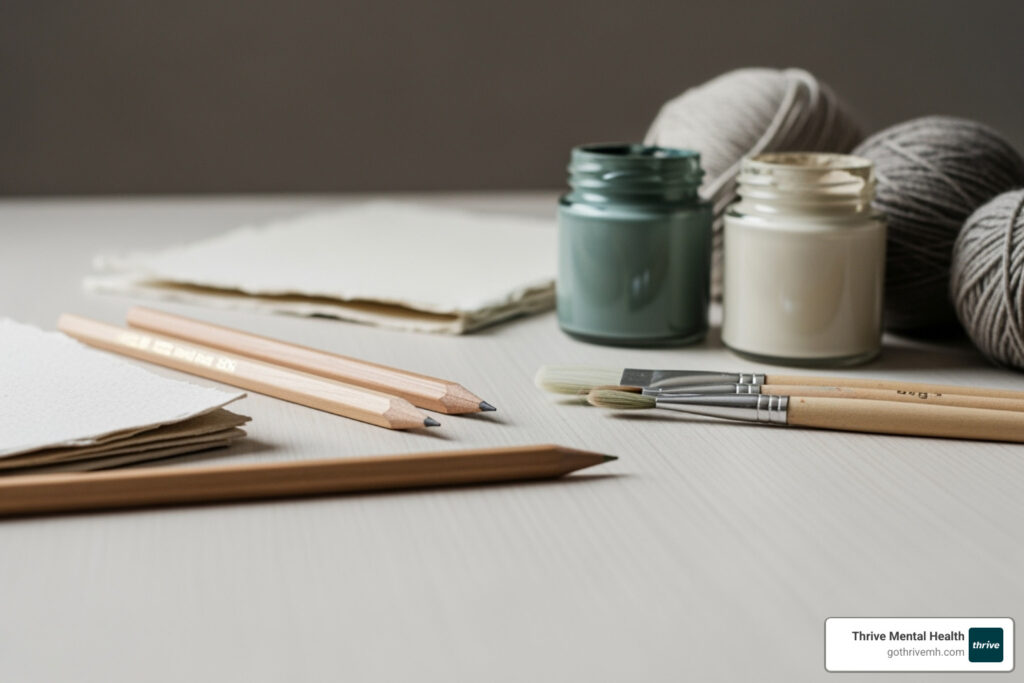
Why Arts and Crafts Transform Mental Wellness
Arts and crafts for mental health patients offer a science-backed path to healing. Research shows creative activities can significantly reduce stress hormones like cortisol while boosting dopamine, the brain’s natural “feel good” chemical.
Here are the top therapeutic benefits:
- Stress Reduction: Lowers cortisol and activates the body’s relaxation response.
- Emotional Expression: Provides a non-verbal outlet for difficult feelings.
- Cognitive Improvement: Improves memory, concentration, and problem-solving.
- Social Connection: Builds community through group activities.
- Self-Esteem Boost: Creates a sense of accomplishment and agency.
The therapeutic power of creative expression isn’t new. Since the late 19th century, occupational therapists have used crafts to help patients recover from trauma and anxiety. Activities once used to help soldiers process shell shock now support modern mental health treatment.
Engaging in creative activities creates what psychologists call a “flow state”—a mindful awareness that reduces negative thoughts and promotes healing, whether you’re managing a specific condition or seeking emotional balance.
I’m Nate Raine, CEO of Thrive Mental Health. In our Florida programs, I’ve seen how arts and crafts for mental health patients complement traditional therapy. My experience has shown me that creative expression isn’t just therapeutic—it’s transformative.
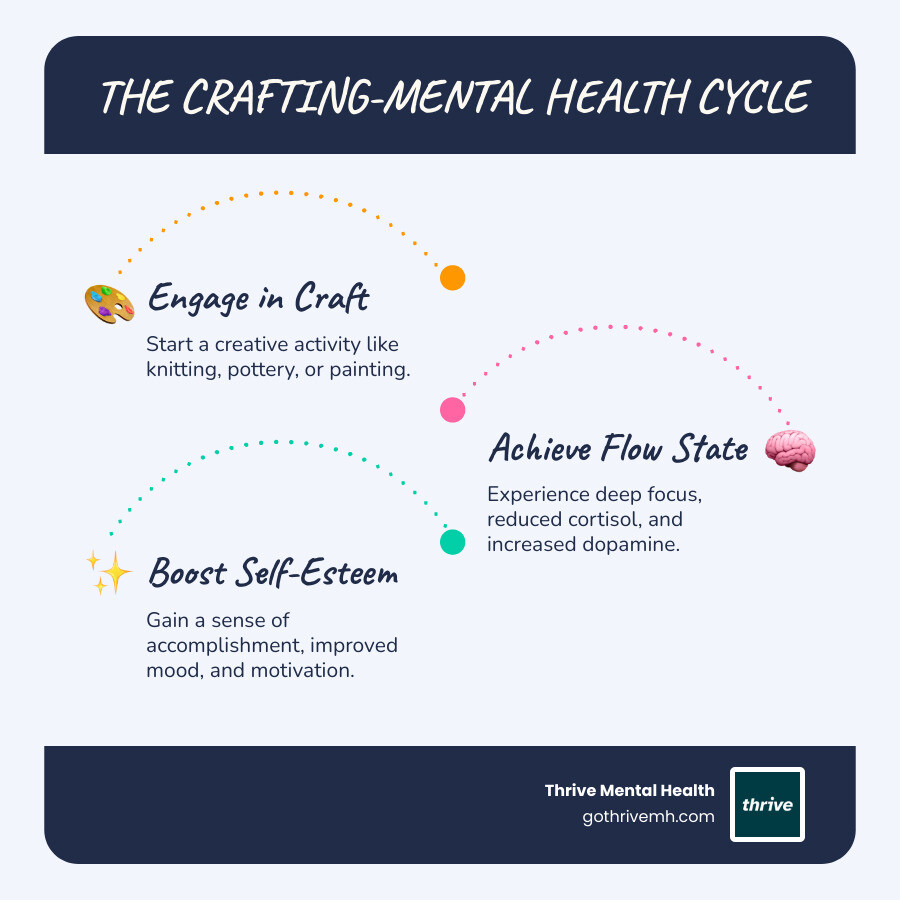
Important arts and crafts for mental health patients terms:
The Science-Backed Benefits of Crafting for Mental Health
The research is clear: arts and crafts for mental health patients create measurable changes in the mind and body, actively rewiring the brain for better wellness.
Stress reduction begins quickly. A study in the Journal of the American Art Therapy Association found that participants experienced significant drops in cortisol levels after just 45 minutes of creative activity. The repetitive motions in many crafts calm the nervous system, similar to meditation.
When words fail, emotional expression through art is a lifeline. For those with trauma or depression, expressing feelings through colors and shapes is often easier than conversation. This non-verbal communication offers a safe way to process difficult emotions.
Crafting also provides cognitive improvement by engaging multiple brain regions. Planning, coordinating movements, and problem-solving strengthen memory, concentration, and critical thinking.
A sense of accomplishment from finishing a project is transformative. This tangible evidence of your capabilities builds self-esteem in a way that positive thinking alone cannot. Furthermore, social connection emerges in group settings, reducing isolation and building community even when working quietly alongside others.
You can explore more about how art therapy improves mental health in various therapeutic settings.
The Historical Roots in Occupational Therapy
Creative healing has deep roots in late 19th-century occupational therapy, which recognized that humans need meaningful occupation to thrive. During WWI, soldiers with shell shock (now PTSD) found relief in crafts like basketry and woodworking. These activities helped rebuild motor skills and mental resilience. This holistic care approach, focused on rehabilitation of the whole person, still guides how we use arts and crafts for mental health patients in our Florida treatment centers today.
How Crafting Creates a State of ‘Flow’
Psychologist Mihaly Csikszentmihalyi defined “flow” as a state of being so absorbed in an activity that time seems to disappear. Crafting is a reliable way to achieve it.
Flow occurs when a task is challenging enough to hold your attention but not so difficult it causes frustration. In this state, mindfulness is effortless. Your focus narrows to the present moment, providing a distraction from negative thoughts. This intense present moment awareness acts as a mental reset, replacing the mental chatter of anxiety and depression with peaceful concentration. The optimal experience of flow reduces stress hormones and boosts feel-good brain chemicals, shifting your nervous system into a restorative mode. This principle is central to our art therapy programs across Florida, where we help patients find a peaceful escape and build resilience.
A Guide to Arts and Crafts for Mental Health Patients
Finding the right creative outlet is key to your healing journey. The beauty of arts and crafts for mental health patients is in the process, not the product. Each craft offers a unique path to wellness, and there’s no wrong way to engage.
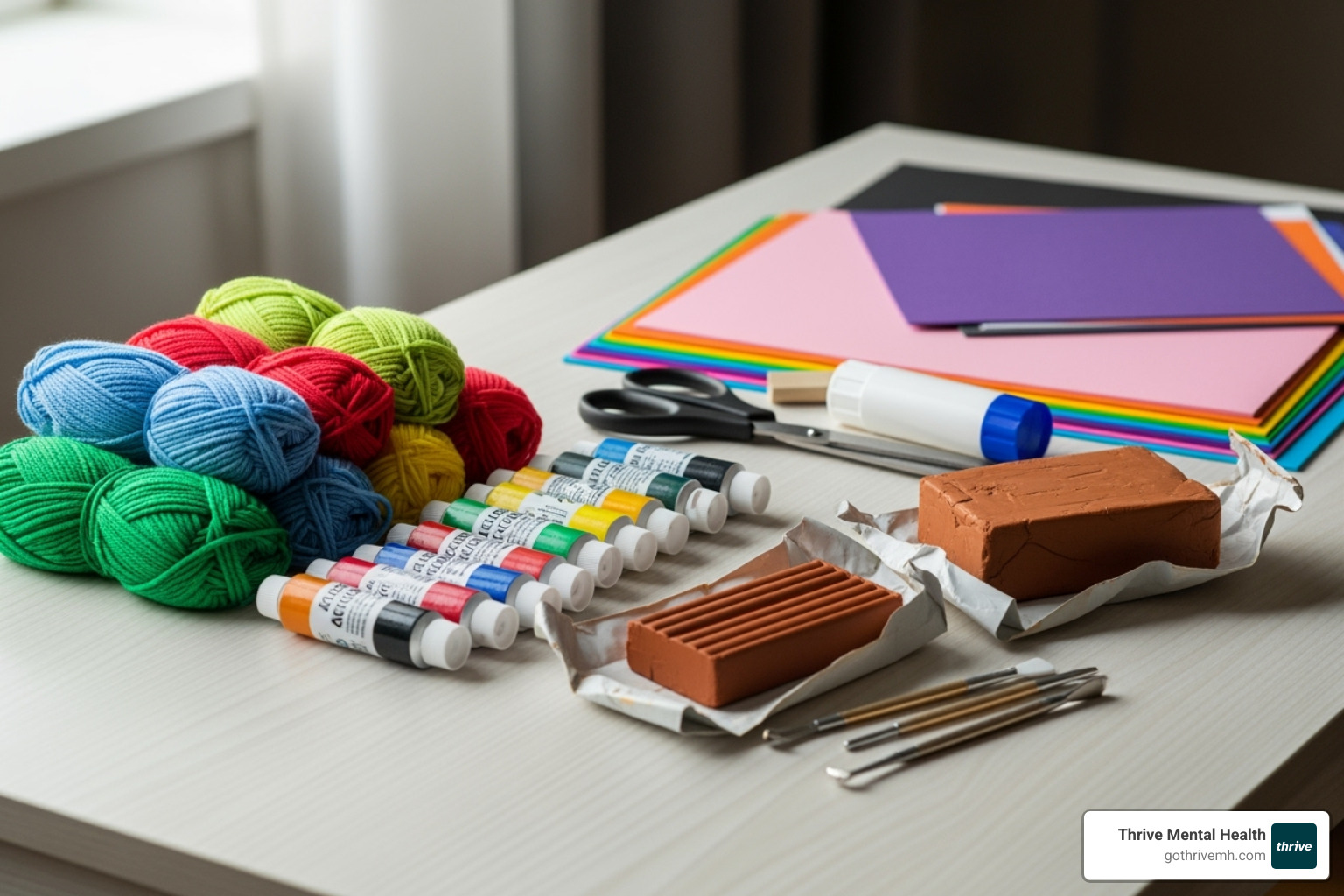
Whether you’re drawn to knitting, clay, or painting, each activity we facilitate in our Florida programs is designed to support your mental wellbeing. Let’s explore how different crafts can help.
Fiber Arts: Weaving Calm with Knitting and Crochet
The gentle click of knitting needles or the pull of a crochet hook can be deeply healing. The repetitive motion calms racing thoughts, acting like meditation in motion. Research shows this quality can reduce anxiety, with one study noting relief among hospitalized patients with anorexia nervosa who began knitting.
Embroidery offers the same soothing repetition, redirecting the mind from worries to the pleasure of creating. Fiber arts engage mind and body, sharpening concentration and problem-solving skills. The tangible results—a finished row or a completed project—represent visible progress, nurturing your mental health. For more ideas, explore our guide to Art Therapy Activities for Anxiety.
Clay and Pottery: Grounding and Shaping Emotions
Working with clay is a primal, grounding experience. The moment your hands touch the cool material, you’re rooted in the present. Pottery and air-dry clay provide powerful sensory engagement, which can be especially helpful when anxiety makes you feel scattered.
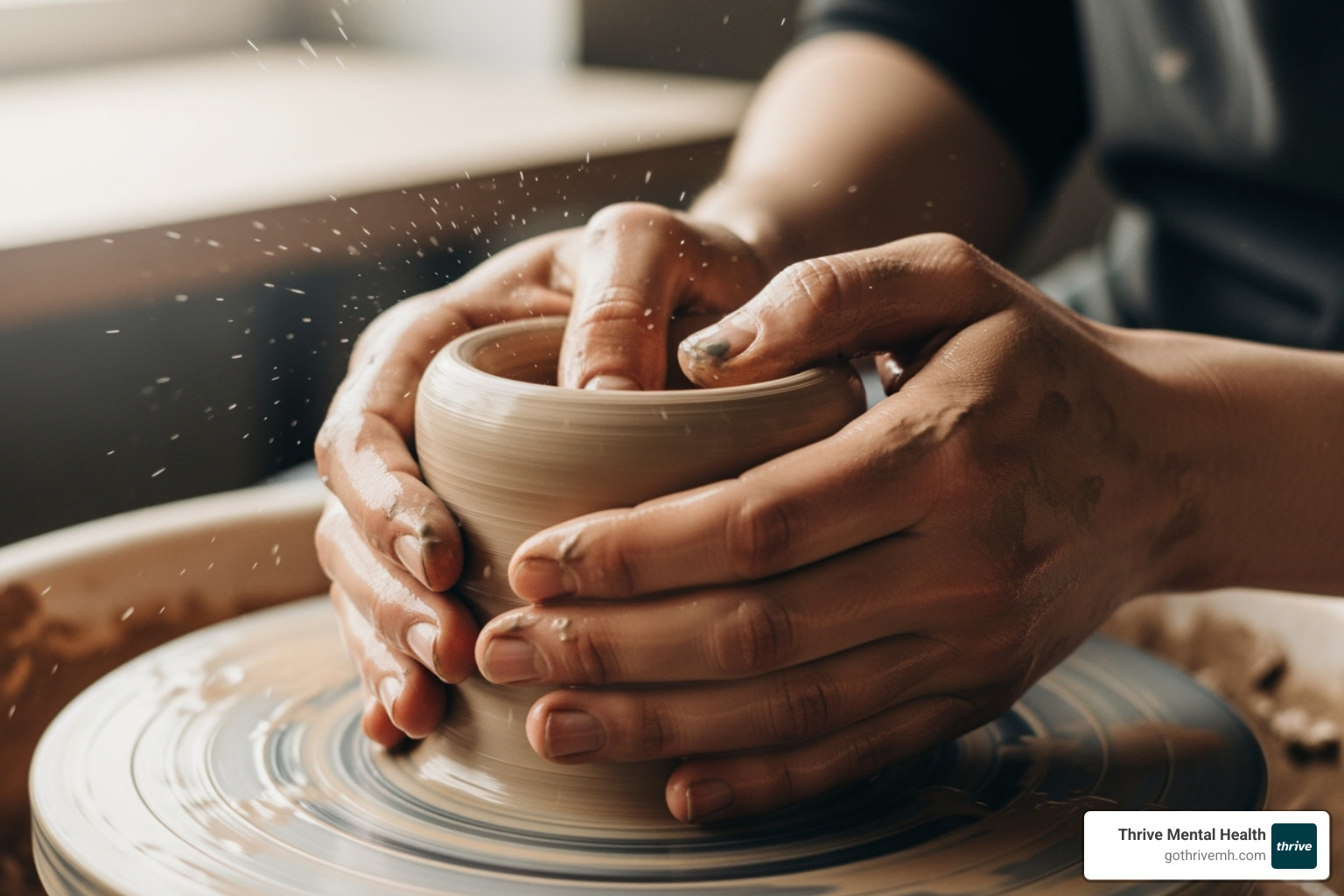
Clay’s forgiving nature allows for emotional catharsis. You can pound, squeeze, or reshape it, making it a powerful metaphor for personal growth. The focus required quiets mental chatter, slows breathing, and relaxes the body. Clay doesn’t demand perfection, making it an ideal medium for anyone exploring arts and crafts for mental health patients. This is just one of the many therapeutic modalities offered in our Florida art therapy programs.
Painting and Drawing: Expressing the Inexpressible
When words fail, painting and drawing can speak volumes, offering a direct path for inner feelings. Abstract art frees you from the pressure of realism, allowing emotions to flow through color and brushstrokes. Self-portraits, whether realistic or abstract, offer a unique chance for self-reflection.
For structure and calm, mandala drawing is ideal. Research shows creating these symmetrical designs can significantly reduce negative emotions. Adult coloring books and Zentangle art are gentle entry points, requiring just enough concentration to quiet the mind. Even simple sketches provide powerful non-verbal expression, helping you process feelings in ways talking alone cannot. Get started with these Easy Mental Health Drawing techniques.
Paper Crafts: Collaging and Journaling for mental health patients
Paper crafts are accessible and versatile. These activities require minimal supplies but offer maximum opportunity for self-expression and storytelling. Collage work is powerful because it removes the pressure of creating from scratch. You curate existing images and words to tell your story, a process that can reveal subconscious thoughts.
Art journaling combines writing with visual expression, creating a private sanctuary for inner exploration. The precise folding of origami calms racing thoughts and improves concentration. Projects like memory boxes and gratitude banners invite reflection and celebrate positivity. These paper-based arts and crafts for mental health patients prove that healing doesn’t require advanced skills, making them perfect for anyone. The no artistic skill needed approach is key. Explore more ideas in our guide to Therapeutic Art Activities.
Getting Started: Adapting Crafts and Finding Guidance
Starting your creative journey doesn’t have to be overwhelming. Give yourself permission to play, explore, and be present with the materials. There’s no wrong way to do it.
Embracing the ‘Process Over Product’ Philosophy
The magic of arts and crafts for mental health patients is in the making, not the final product. Perfectionism is a barrier to creative healing. The benefits come from letting go of expectations and experiencing the materials in your hands.
This process over product mindset cultivates self-compassion. Instead of criticizing a crooked line, you appreciate the meditative rhythm of your hands. Mindfulness emerges when you stop worrying about the outcome. Your attention settles into the present moment, which is where anxiety melts away. When you accept the journey, crafting becomes a sanctuary, not a source of pressure.
Adapting Activities for Different Needs and Abilities
Creative expression is highly adaptable. For physical limitations, try large-handled tools or pre-cut materials. For cognitive challenges, break activities into smaller steps or use structured kits like adult coloring books. The goal is to find a “just right challenge” that is engaging but not frustrating.
The sensory experience—the feel of clay, the smell of paint, the texture of yarn—can be deeply calming. Giving yourself choice and control over materials and themes reclaims a sense of agency. Starting with simple vs. complex projects that can be completed quickly provides immediate satisfaction and builds confidence.
The Role of a Facilitator in Therapeutic Arts and Crafts for mental health patients
While crafting alone is beneficial, a trained facilitator can deepen the therapeutic impact. An art therapist or occupational therapist uses specific materials and techniques to address therapeutic goals, such as processing trauma or managing anxiety.
Their most important role is creating a safe space free from judgment, where experimentation is encouraged. This is crucial for those who feel vulnerable about expressing themselves. Professional guidance is also valuable when strong emotions surface, as a facilitator can help you steer these feelings constructively.
In group settings, facilitators ensure everyone feels included and supported. For those in intensive outpatient (IOP) or partial hospitalization (PHP) programs, professional facilitation integrates creative expression with other evidence-based treatments. At Thrive Mental Health, our expert-led programs in Florida use this holistic approach, where art therapy complements treatments like CBT. Our facilitators understand that arts and crafts for mental health patients are powerful tools for healing. Learn more by exploring Integrating Art Therapy into Intensive Outpatient Programs in South Florida: A Closer Look.
Frequently Asked Questions about Arts and Crafts in Mental Health
Do I need to be “good at art” to benefit from these activities?
Absolutely not. You don’t need any artistic talent to benefit from arts and crafts for mental health patients. The most powerful breakthroughs often happen when people let go of being “perfect” and simply explore.
The healing happens in the doing, not the final product. Your nervous system responds to the rhythmic process and focused attention, not the quality of the artwork. Your stress hormones drop whether you create a masterpiece or a mess. Activities like adult coloring, collage, or doodling require zero artistic skill but can be incredibly powerful. The goal is to create a safe space for expression, not to impress anyone.
What’s the difference between art therapy and just doing crafts at home?
Both are valuable, but they serve different purposes. Art therapy is a formal clinical practice led by a licensed professional with training in art and psychology. They use creative expression to address specific therapeutic goals as part of a structured treatment plan. The therapist helps you explore the meaning behind your creations to advance your healing journey.
Self-directed crafting at home is a form of creative self-care. Its goal is general wellbeing, like knitting to unwind. While both approaches reduce stress and boost accomplishment, home crafting is great for daily maintenance, whereas formal art therapy addresses deeper psychological challenges with professional guidance.
At Thrive Mental Health, we value both. Our programs in Florida include guided creative activities, and we encourage clients to continue exploring creativity on their own. Learn more in our Understanding Art Therapy: Comprehensive Overview.
Can arts and crafts really help with serious conditions like depression or PTSD?
Yes, but they work best as part of a comprehensive treatment plan, not as a standalone cure. For PTSD, art offers a non-verbal way to process trauma when words are too painful. Creative expression can help externalize experiences safely, a crucial first step toward healing.
With depression, creating something boosts dopamine, your brain’s natural antidepressant. The simple act of choosing colors or shaping clay provides a spark of engagement. Studies show arts and crafts for mental health patients can significantly reduce symptoms, improve mood, and improve coping skills.
Creative activities can help when other approaches feel stuck. At Thrive Mental Health, integrating creative expression into our evidence-based programs in Florida improves treatment outcomes. Professional support is key to processing what comes up and integrating these experiences into your broader healing.
Conclusion
The journey through arts and crafts for mental health patients shows that healing can happen anywhere—with paint-stained fingers, knitting needles, or clay.
These creative activities are accessible, powerful, and transformative. When you engage in a craft, you are actively reducing stress hormones, expressing emotions, boosting cognitive function, and connecting with others.
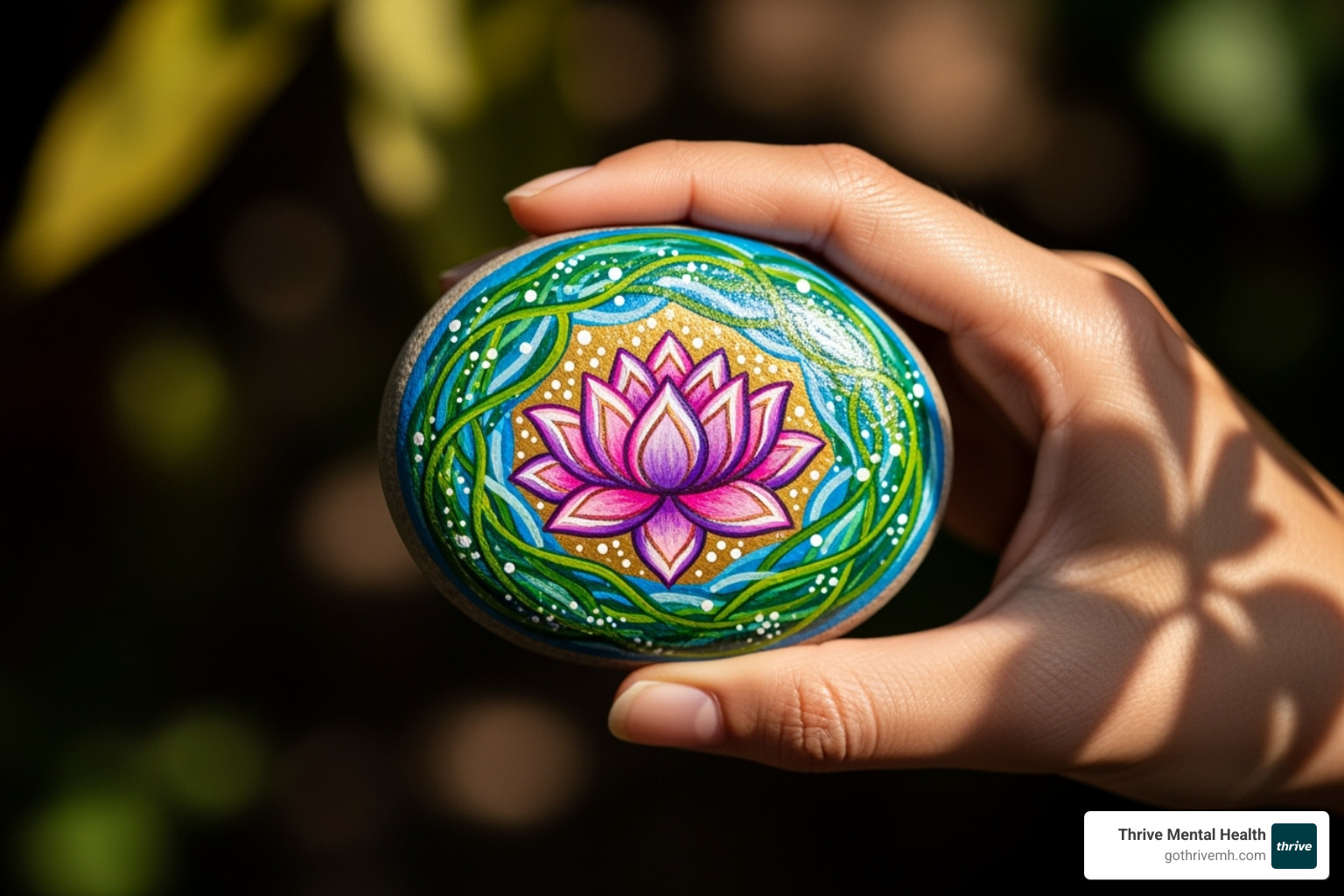
There is no wrong way to approach creative healing. The magic is in the ‘process over product’ philosophy. Your art doesn’t need to be perfect; it just needs to help you feel better and express what words can’t.
You can start today with any materials you have. Every creative act is one of courage and self-care.
At Thrive Mental Health, we’ve seen individuals find new parts of themselves through arts and crafts for mental health patients. Our flexible IOP/PHP programs across Florida weave creative approaches like art therapy into our evidence-based care. We understand that healing isn’t one-size-fits-all and are here to support you.
Learn more about how our Art Therapy programs can support your mental wellness journey.